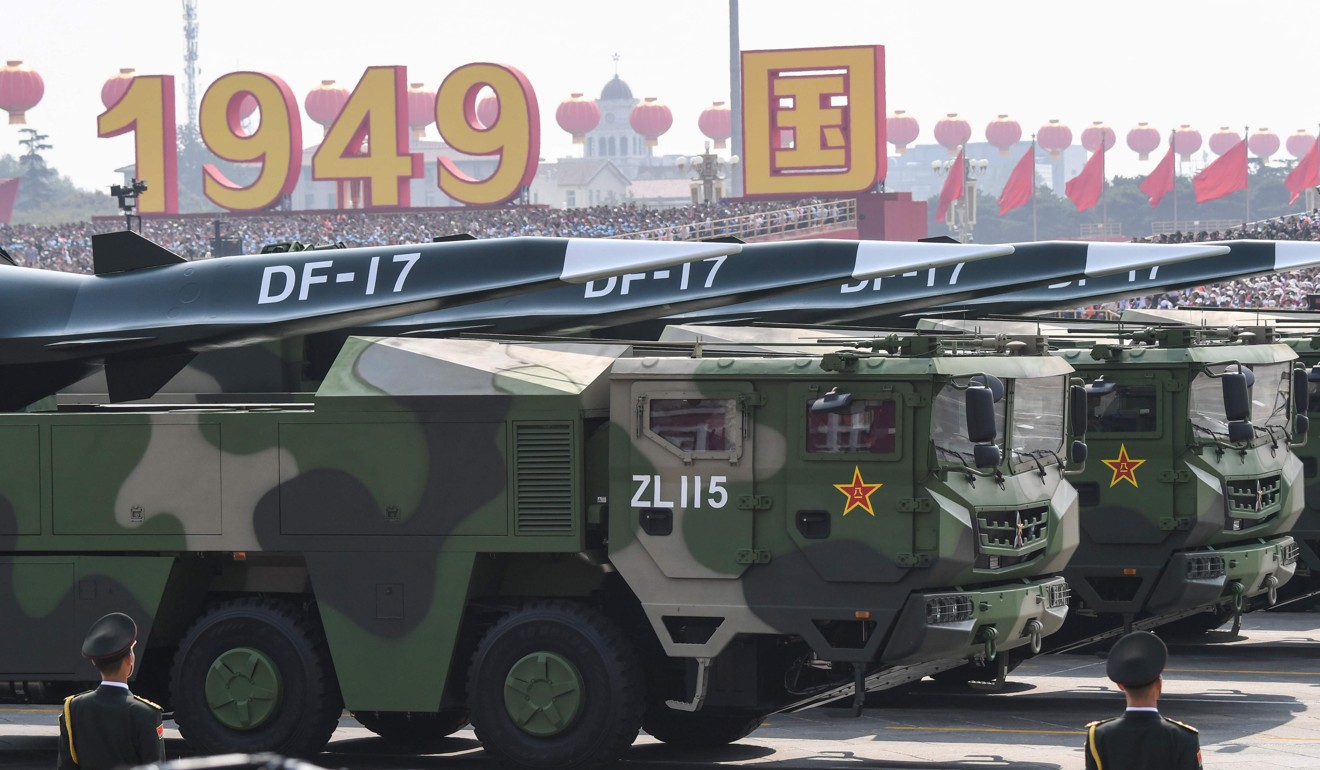
China rolls out new weapon systems, nuclear-capable missiles in military parade
- DF-17 hypersonic ballistic missile and new-generation road-mobile DF-41 draw attention as they make their debut
- For China it is a show of how its armed forces have been modernised, but one analyst calls it ‘the ultimate show of insecurity and cold war thinking’
The parade involved 15,000 troops from 59 units – 47 on the ground and a dozen airborne squadrons – showing how the world’s biggest armed forces have been modernised in the seven years since President Xi Jinping took the helm.
Xi, who also chairs the Central Military Commission, inspected 580 new weapon systems, and analysts noted that almost all of them were made in China, as its military industry becomes more self-sufficient.
Among them, the Dongfeng, or “East Wind”, series of missile systems drew the most attention. They included the DF-17 hypersonic ballistic missile, DF-16 and DF-26 medium-range missiles, and the DF-31AG and DF-41 intercontinental ballistic missiles.
The DF-17 – which has a hypersonic glide vehicle that can deliver both nuclear and conventional payloads – was one of the systems making its debut. But the missile in the parade was equipped with a conventional warhead, according to state broadcaster CCTV.
Hong Kong-based military commentator Song Zhongping said the ballistic missile could precisely hit a target within China’s so-called first island chain that takes in Okinawa, Taiwan and the Philippines, which Beijing sees as a defence line, particularly against the US military presence in the region.
“The military science and technology race is getting more intense, and China is trying to catch up and put more resources into hypersonic weapons like the DF-17 since the United States, Russia and other countries are all trying to do it,” he said. “But despite being a latecomer, it’s a fact that China has pulled ahead in hypersonic weapon development. Even the US is still developing a hypersonic weapon for its ground force, navy and air force.”
The DF-17’s hypersonic glide vehicle can reportedly travel at well above the speed of sound and penetrate US missile shields. It will replace the DF-11 and DF-15 short-range ballistic missiles.

China’s intercontinental ballistic missiles also caught the attention of military enthusiasts. Seen in the parade was a ground-based version of the DF-31AG, as well as the JL-2, or “Big Wave”, which is launched from a submarine and has multiple re-entry vehicles that can zero in on different targets, and a new-generation road-mobile DF-41 – a nuclear-capable missile that was also making its debut.
The DF-41 has the longest range in the Dongfeng series at 12,000km to 15,000km, meaning it can reach any location on the US mainland from China. It can be fitted with up to 10 multiple re-entry vehicles, each containing multiple nuclear warheads.

It was Xi’s fifth time to review a huge military parade. The most recent was in April, when the Chinese navy marked its 70th anniversary with a naval parade in Qingdao, Shandong province.
Beijing-based miliary expert Zhou Chenming said Xi had pushed weapons innovation and combat-ready training over the past seven years.
“All the weapon systems in the parade are what they would use in a battle situation, so you can see that even the uniforms and gear of the field army are now more like the Americans’,” Zhou said.
Retired PLA colonel Yue Gang noted that the People’s Liberation Army had sought to catch up with the US military in terms of its structure and weapon systems.
“The formations seen in the parade also suggest a new type of Chinese military after the sweeping overhaul … which shows the importance of an information-led and joint operational approach in modern warfare,” Yue said.
As part of that overhaul, Xi streamlined the PLA’s seven military commands into five theatre commands and replaced its four general headquarters with 15 smaller functional departments.
Xi also announced four years ago that the PLA would shed 300,000 troops, reducing its size to 2 million – a move aimed at turning it into a more nimble and combat-ready fighting force on a par with international standards.
And he split the Second Artillery Corps into two, creating a Rocket Force and a Strategic Support Force, which backs up the military’s electronic warfare units in cyberspace and outer space. Troops from both of these new forces were among the squads on the ground inspected by Xi.
While there were no brand new aircraft making their debut, some modified versions of older models were among the airborne squadrons, led by the KJ-2000 early warning aircraft that flew past PLA Air Force Commander Ding Laihang.
“The H-6 series of bombers and variants like the H-6K, H-6N and the HU-6 refuelling aircraft, plus a series of electronic surveillance aircraft based on the Y-8 transport planes were all on show,” Macau-based military analyst Antony Wong Dong said.
“There were also three types of training warplanes, showing the PLA Air Force has developed a systematic training and battle system,” he said.
Did China just accidentally show off its new supersonic cruise missile?
The H-6 was designed as a medium-range bomber, but the bomb bay was removed from its latest incarnation, the H-6K, to allow for greater fuel storage and a longer range. The newest bomber instead carries cruise missiles under its wings, with a range of more than 2,000km. That would mean it could attack Alaska, Guam, Hawaii, Japan, Malaysia, the Philippines, Vietnam or even Moscow without having to leave its air defence zone on the Chinese mainland. Since late 2017, the H-6K has been deployed to the Taiwan Strait to conduct “island encirclement” exercises around Taiwan.


